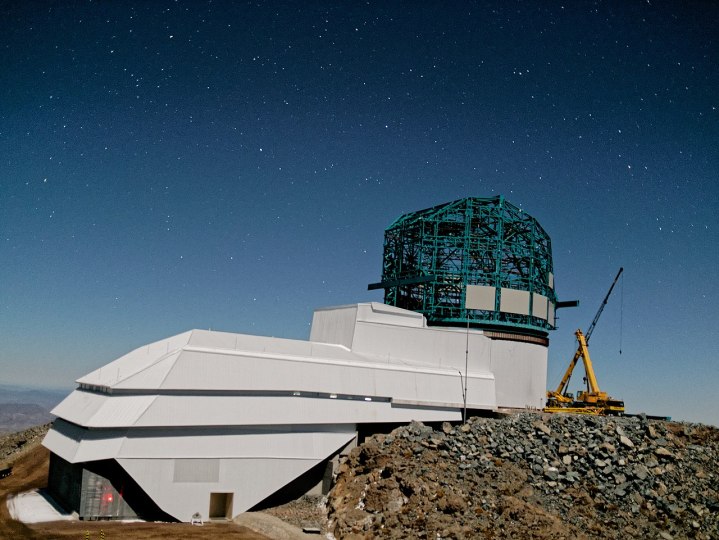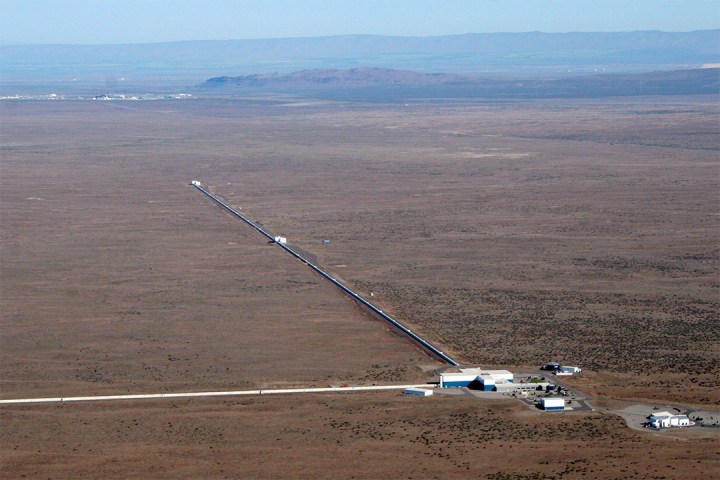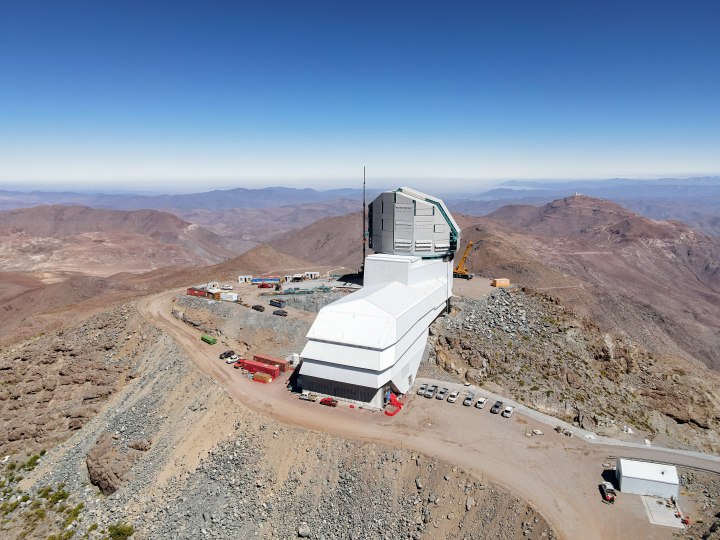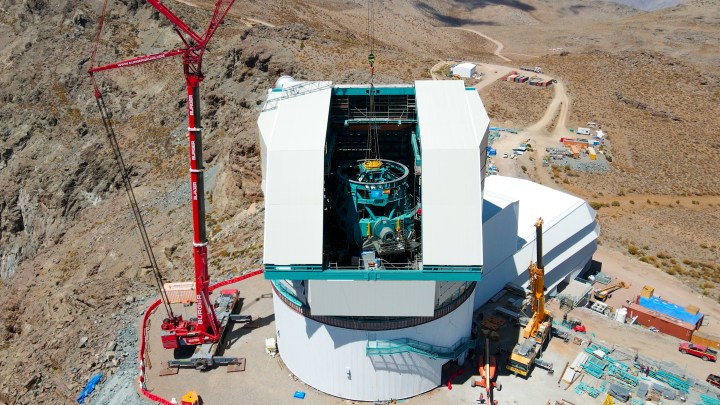
When you hear about big science projects like a huge new telescope or a miles-long particle accelerator, it’s usually in the context of the big science discoveries they’ve made. But before anyone can make a big science breakthrough, someone needs to design and build these massive facilities. And that can mean corralling international collaborations, running power lines, and facing extreme weather conditions just to get the concrete poured.
From rats chewing at fiber optic lines to inflatable tents to keep out the 100-degree heat, science can be messy when it meets the real world. We spoke to representatives from three current and upcoming big science projects to learn what it takes to turn a barren patch of rock and dirt into a world-class observatory.
Detecting something new
Many big facilities are incremental improvements on existing projects, but sometimes science takes a step forward in an entirely new direction. That’s what happened when it came to detecting gravitational waves for the first time, which the LIGO (Laser Interferometer Gravitational-Wave Observatory) facility achieved in 2015, and for which the researchers were awarded the Nobel Prize in physics.

The facility that made its detection began as a bare-bones version called Initial LIGO. It was designed to test whether it was even possible to achieve the sensitivity of detectors required to detect gravitational waves, and even this “basic” version took decades of planning and work.
Stefan Ballmer, a gravitational wave expert at Syracuse University who worked on both the initial and advanced versions of the facility, described the impetus for the original facility: “We think we can achieve this incredible sensitivity, so let’s spend the least amount of money to prove that it’s feasible.”
“As soon as we really turned the machine on, we started seeing events.”
Initial LIGO was operational from 2002 to 2010; during that time, it did not detect any gravitational waves. That wasn’t necessarily a failure, though, because the observatory did achieve the sensitivity that was required to make a detection — something that many people weren’t sure was possible.
“If people had doubts about the whole thing, it’s not that they didn’t believe gravitational waves existed. They were skeptical about the performance required to see them. And in that sense, Initial LIGO delivered,” Ballmer explained.
So, the researchers were able to secure funding to upgrade the facility to become Advanced LIGO, with work beginning in 2008. With improved detectors, the observatory made a detection almost immediately. “With Advanced LIGO, we got lucky. And as soon as we really turned the machine on, we started seeing events.”
Choosing the right location
One of the biggest issues with large-scale projects today is where to locate them. These kinds of projects are usually big, international cooperations, so planners need to find a site that is both environmentally suitable and has a local government willing to support the project.
“That’s the big challenge these days — a single nation can’t really do things that are required on the scale for the next frontiers,” said Joseph McMullin, Deputy Director General and Program Director at the Square Kilometre Array Observatory. “So it requires these international collaborations.”

The Square Kilometer Array is an upcoming radio astronomy observatory that includes antennas built over two sites, one in South Africa and one in Western Australia. These sites were chosen primarily because of the biggest concern for radio observations — radio frequency interference. Wherever humans are producing radio waves, such as from mobile phones and laptops, this radiation can interfere with the faint signals that astronomers try to detect.
“The challenge of what we’re doing is looking at very faint sources, through various screens of our atmosphere, and even through the interstellar medium or intergalactic medium in some cases, and then all the systematics of our instruments — then trying to calibrate those out so we can retain that specific signal,” McMullin explained. “Additional transmissions complicate those sorts of effects.”
The issue is that the locations with low levels of radio interference also tend to be sparsely populated, making them challenging to build in. In theory, somewhere like Antarctica would be the perfect place to put a radio telescope — but the difficulties of building and staffing in such a location make it impractical.
“We often think we’re building an observatory, but really we’re building cities.”
The two sites chosen for SKA have the advantage of having some existing infrastructure because they already host telescopes hosted by partner institutions. Clustering telescopes together in appropriate locations helps share the load when it comes to requirements like constructing roads or running power and water lines.
And that’s all necessary before you can even begin to build structures like accommodation and canteens for the workers required for construction. “We often think we’re building an observatory, but really we’re building cities,” McMullin said.
Sharing the load
When researchers were planning for the upcoming Vera Rubin Observatory, which is being built on a mountain called Cerro Pachón in Chile, they had similar concerns. They needed a location with low cloud cover and plenty of clear nights for their observations, but they also wanted somewhere with decent infrastructure.
The mountain they chose already hosts two other large telescopes, Gemini and SOAR, as well as other smaller instruments and more located on the next mountain over.

“We are very remote, but not isolated,” Jeff Barr, Telescope & Site Project Manager for Rubin Observatory, explained. “We have neighbors, and the neighbors needed infrastructure that they had already built.”
That meant that power and water were already available nearby, as were the all-important roads that allowed construction crews and equipment to get up the mountain. There was also an existing communication infrastructure, which was an antenna-based broadcast system, but that wouldn’t have been sufficient for the huge quantity of data that will be produced by Rubin every night.
So Rubin agreed to lay in fiber optic lines for communication, which would not only serve its own observatory but also the others on the mountain. The observatories are part of the same consortium, called AURA (Association of Universities for Research in Astronomy), so they share mutual infrastructure.
“There’s a kind of buy-in that every new observatory does,” Barr said. “It provides something that wasn’t already there, so you are co-sharing the cost and investment required to work on the mountain.”
Laying the groundwork
You might imagine it would be a simple matter to lay in a fiber optic line — not so different from the companies that increasingly offer fiber connections to residential households in many urban areas. However, there are some challenges to building in such a remote location.
There were existing power lines hung from poles across the valley, so teams could use these same poles to hang the fiber lines. But after being split for Rubin and the other observatories, the line must go mostly underground.

“One of the challenges of working on that mountain is that as soon as you start to dig, six inches down, it’s solid rock. Very solid,” Barr said. “You have to practically blast it to make a hole of any size.”
That makes jackhammering difficult, so often, the line will be laid as deep as possible, and then rock is mounded on top of it. That rock provides some protection, but the line is still vulnerable to the local population of rodents, who regularly chew on the cables. “We have pest control services all the time, but even then we still have to back in and make repairs when a line gets chewed.”
Barr said that hungry rodents are part and parcel of working in such a wild environment: “It’s very natural. Except for the areas right around the observatories, it’s pretty much just the mountain.”

The observatories work within guidelines to minimize impact on the environment, including the habitats of some threatened species of cacti and viscachas, rare (and extremely cute) rabbit-like rodents which live in the area.
The heritage impact
Preservation concerns don’t only apply to environmental issues, though. Some of the sites used for observatories are of heritage importance to humans. The SKA site in Western Australia, for example, is located on Wajarri Country. The Wajarri Yamaji are the traditional owners of the land where the telescope is being built, so the organization works with the Wajarri to ensure cultural heritage is protected, such as carrying out walkthroughs on-site with Wajarri cultural heritage monitors before breaking ground and ongoing monitoring during construction.

“These are our colleagues and neighbors, and they’re part of the team on a fundamental level. Many of them are taking up positions with us to build the observatory,” McMullin said. “They have a strong history and heritage of astronomical observation as well. So it’s linking these things together across the different techniques that one uses.”
There’s also a consideration of the long-term impacts of both the Australian and South African sites, which have been designed to be eventually decommissioned so that the land can be returned to its original state.
“We’re planning this to be a 50-year observatory,” McMullin said. “So you go there, you build, you do your research, and then you decommission. You return that area to the same state that it was in.”
Building in a difficult environment
Whether it’s temperatures over 100 degrees Fahrenheit in Western Australia or high winds and earthquake risks at Cerro Pachón, the locations where you might want to build an observatory are not often welcoming to construction.
Access to the mountain in Chile can be cut off for weeks during winter time when it snows, and even when it is accessible, the conditions mean that work takes longer than it would elsewhere.

“You have to understand that things aren’t going to be as fast as you expect them to be,” Barr said. “It’s a hostile and unwelcoming environment to try to do a technical job. You have to take that into account in practically everything that you design.”
“It’s ironic that the biggest piece of the detector is absolutely nothing.”
In Australia, the SKA teams need to install more than 100,000 antennas at many different sites, so they manage the high temperatures and high UV by preparing as much of the installation as they can off-site. When they do arrive on site, they will use specially designed inflatable, air-conditioned tents to protect them from the elements while they work.
But even locations that aren’t so harsh have their challenges. For the next generation of gravitational wave detectors, the designers must run very straight, very flat tubes 25 miles long.
“It’s ironic that the biggest piece of the detector is absolutely nothing,” Ballmer said. “It’s a vacuum tube 40 kilometers long, and you have to fit that somewhere.”
For detectors being planned in the U.S., the idea is to run these mostly above ground as there should be sufficient space to do so. In Europe, however, where another gravitational wave detector is also being planned, there isn’t enough surface land to run an overground detector, so it will likely have to go underground. That adds expense to the construction, but it also makes maintenance much more complicated.
“It’s simplicity that we’re after,” Ballmer said. “It’s complicated enough, building these detectors! Everything we can keep simple is better.”
The human factor
Getting machines and equipment up to the site is one thing, but even with all the tools in the world, construction still needs to be done by people. At Rubin, a team of over 100 workers could be on-site daily during construction. “I think the toll on the working force — the human factor — is as challenging as anything else,” Barr said. “It’s just such a difficult environment.”
Not only do workers have to contend with the cold, windy, dusty, and high-altitude conditions found at the top of a mountain, but it takes several hours to travel up to the site, so many will spend twelve hours per day away from home, leaving at 6 a.m. “It’s really the people that are most amazing to me,” Barr said. “They can work up there in that environment and get these tough things done.”

These kinds of projects take decades to go from conception to design to construction to commissioning to a functioning observatory, so it’s entirely possible that the people who originally pushed for their construction will be retired by the time they begin doing science. But that isn’t necessarily a problem, as previous generations build and pass on tools for the new generations of scientists who are just beginning their careers.
That sense of obligation to the future is part of the motivation for getting new gravitational wave detectors built, Ballmer said, but there’s also a joy in thinking through how such a thing could be achieved.
“It’s on some level a service to the next generation of physicists.”
“It’s on some level a service to the next generation of physicists,” Ballmer said. “But also, when you sit down and see what’s possible with these machines — that you can build something that sees every black hole right back to the very first stars, that you can observe phenomena from stellar size objects that are in these galaxies that even the Webb telescope has trouble resolving — not trying to do that would be almost a crime.”




